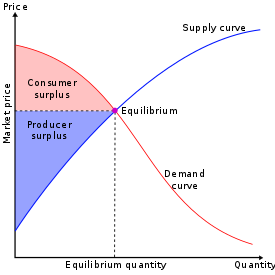
Back فائض اقتصادي Arabic İqtisadi artıq Azerbaijani অর্থনৈতিক উদ্বৃত্ত Bengali/Bangla Excedent Catalan زێدەوەری ئابووری CKB Ekonomický přebytek Czech Forbrugeroverskud Danish Rente (Wirtschaft) German Ekonomia pluso Esperanto Excedente Spanish

| Part of a series on |
| Capitalism |
|---|
In mainstream economics, economic surplus, also known as total welfare or total social welfare or Marshallian surplus (after Alfred Marshall), is either of two related quantities:
- Consumer surplus, or consumers' surplus, is the monetary gain obtained by consumers because they are able to purchase a product for a price that is less than the highest price that they would be willing to pay.
- Producer surplus, or producers' surplus, is the amount that producers benefit by selling at a market price that is higher than the least that they would be willing to sell for; this is roughly equal to profit (since producers are not normally willing to sell at a loss and are normally indifferent to selling at a break-even price).[1][2]
The sum of consumer and producer surplus is sometimes known as social surplus or total surplus; a decrease in that total from inefficiencies is called deadweight loss.[3]
- ^ Boulding, Kenneth E. (1945). "The Concept of Economic Surplus". The American Economic Review. 35 (5): 851–869. JSTOR 1812599.
- ^ "Consumer and producer surplus|Microeconomics|Khan Academy". Khan Academy.
- ^ "Economic efficiency (article)". Khan Academy. Retrieved 2023-07-15.
© MMXXIII Rich X Search. We shall prevail. All rights reserved. Rich X Search